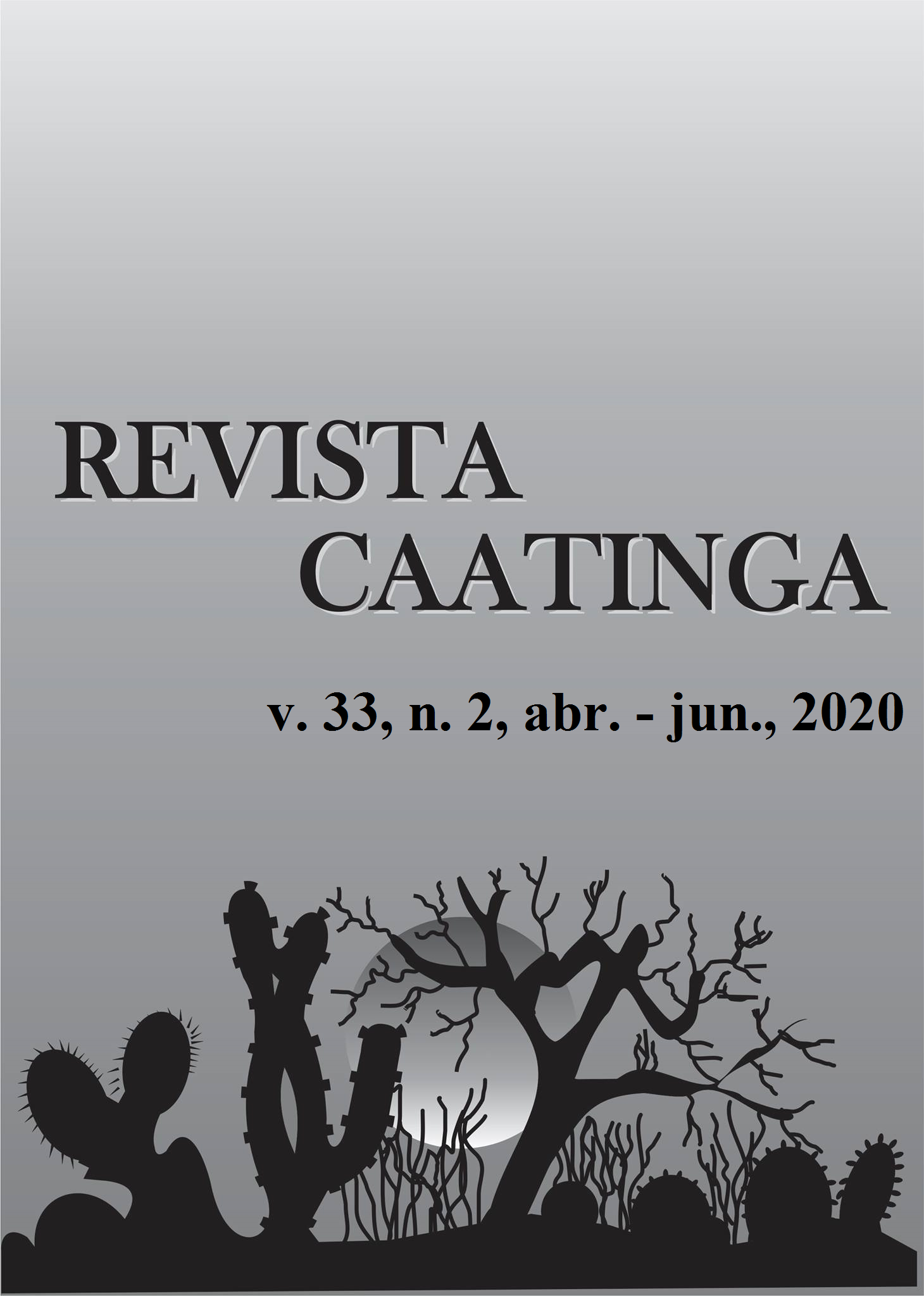ORGANIC MULCH ON EARLY GARLIC CULTIVARS GROWN UNDER SEMIARID CONDITIONS
DOI:
https://doi.org/10.1590/1983-21252020v33n214rcKeywords:
Allium sativum L. Adaptation. Mulching. Copernicia cerifera straw. Yield.Abstract
Soil cover with plant residues is a traditional cultural practice in garlic crops, mainly among small producers. Virus-free garlic seeds is a recent technology used in several garlic producing regions of Brazil; it enables the maximum exploration of the productive potential of cultivars. A field experiment was developed from May to September 2018 with the objective of evaluating the use of mulching in early garlic cultivars in semiarid conditions. A randomized block experimental design was used, with a split-plot arrangement and four replications; the plots consisted of treatments with and without mulch in the plots, and the subplots consisted virus-free garlic cultivars (Araguari, Cateto Roxo, Canela de Ema, Centralina, and Gravatá) and an infected cultivar (Branco Mossoró). The soil mulch did not affect the plant height and number of leaves, but promoted increases in total and commercial yields of the cultivars, especially the Gravatá, indicating that the use of this practice is important to obtain bulbs with higher commercial value; the cultivars Branco Mossoró, Canela de Ema, and Centralina had higher number of cloves per bulb and, thus, are more indicated for the climatic conditions of the region.
Downloads
References
ALVARES, C. A. et al. Köppen’s climate classification map for Brazil. Meteorologische Zeitschrift, 22: 711-728, 2013.
FERREIRA, D. F. SISVAR: Um programa para análises e ensino de estatística. Revista Symposium, 6: 36-41, 2011.
FILGUEIRA, F. A. R. Novo Manual de Olericultura: Agrotecnologia moderna na produção e comercialização de hortícola. 3. ed. Viçosa, MG: UFV, 2013. 421 p.
FIRISSA, O.; SEYOUM, T.; ABEGAZ, F. Effect of drip lateral spacing and mulching on yield, irrigation water use efficiency and net return of onion (Allium cepa L.) at Ambo, Western Shoa, Ethiopia. Journal of Horticulture and Forestry, 11: 62-69, 2019.
HENRIQUES, G. P. A. et al. Resposta do alho nobre vernalizado à adubação nitrogenada nas condições de cultivo do semiárido tropical. Científica, 47: 62-69, 2019.
HOLANDA, J. S. et al. Indicações para adubação de culturas em solos do Rio Grande do Norte. Parnamirim, RN: EMPARN, 2017. 62 p. (Documentos, 46)
HONORATO, A. R. F. et al. Avaliação de cultivares de alho na região de Mossoró. Revista Caatinga, 26, 80–88, 2013.
KABIR, M. A. et al. Effect of mulching and tillage on yield and keeping quality of garlic (Allium sativum L.), Bangladesh Journal of Agricultural Research, 38:115-125, 2013.
KUMAR, S. D.; LAL, B. R. Effect of Mulching On Crop Production under Rainfed Condition: A Review. International Journal of Research in Chemistry and Environment, 2: 8-20, 2012.
LIMA, M. F. P. et al. Garlic quality as a function of seed clove health and size and spacing between plants. Revista Caatinga, 32: 966-975, 2019.
LOPES, W. A. R. et al. Produção de alho submetido a períodos de vernalização e épocas de plantio em região de clima semiárido. Horticultura Brasileira, 34: 249-256, 2016.
LUCENA, R. R. M. et al. Productive performance of vernalizated semi-noble garlic cultivars in western Rio Grande do Norte state, Brazil. Revista Caatinga, 29: 327-337, 2016.
MORAVČEVIĆ, D. et al. The effect of soil mulching on the quality of the bulb and the yield of different autumn garlic genotypes. IN: INTERNATIONAL SCIENTIFIC AGRICULTURAL SYMPOSIUM (AGROSYM), nº 5, 2014, Jahorina. Proceedings…East Sarajevo: Faculty of Agriculture, 2014, p. 403 – 408.
RÊGO, L. G. S. et al. Pedogênese e Classificação de Solos da Fazenda Experimental “Rafael Fernandes” no município de Mossoró, RN. Revista Caatinga, 29: 1036-1042, 2016.
RESENDE, F. V.; DUSI, A. N.; MELO, W. F. Recomendações básicas para a produção de alho em pequenas propriedades. Brasília, DF: Embrapa/CNPH, 2004. 12p. (Comunicado Técnico, 22).
RESENDE, J. T. V. et al. Caracterização morfológica, produtividade e rendimento comercial de cultivares de alho. Horticultura Brasileira, 31: 157-162, 2013.
SEIFU, W. et al. Evaluation of Different Mulching Practices on Garlic (Allium sativum L.) Growth Parameters under Irrigated Condition in Fiche, North Shoa Ethiopia. Journal of Biology, Agriculture and Healthcare, 7: 25-31, 2017.
SOARES, A. M. et al. Avaliação de cultivares de alho no município de Governador Dix-sept Rosado-RN, Brasil. Revista Agro@mbiente On-line, 9: 423-430, 2015.
SILVA, O. M. P. Crescimento, acúmulo de macronutrientes e adubação fosfatada de alho nobre em região de altitude no semiárido. 2019. 110 f. Tese (Doutorado em Fitotecnia; Área de concentração em Práticas Culturais) - Universidade Federal Rural do Semi-Árido, Mossoró, 2019.
Downloads
Published
Issue
Section
License
Os Autores que publicam na Revista Caatinga concordam com os seguintes termos:
a) Os Autores mantêm os direitos autorais e concedem à revista o direito de primeira publicação, com o trabalho simultaneamente licenciado sob a Licença Creative Commons do tipo atribuição CC-BY, para todo o conteúdo do periódico, exceto onde estiver identificado, que permite o compartilhamento do trabalho com reconhecimento da autoria e publicação inicial nesta revista, sem fins comerciais.
b) Os Autores têm autorização para distribuição não-exclusiva da versão do trabalho publicada nesta revista (ex.: publicar em repositório institucional ou como capítulo de livro), com reconhecimento de autoria e publicação inicial nesta revista.
c) Os Autores têm permissão e são estimulados a publicar e distribuir seu trabalho online (ex.: em repositórios institucionais ou na sua página pessoal) a qualquer ponto antes ou durante o processo editorial, já que isso pode gerar alterações produtivas, bem como aumentar o impacto e a citação do trabalho publicado (Veja O Efeito do Acesso Livre).







